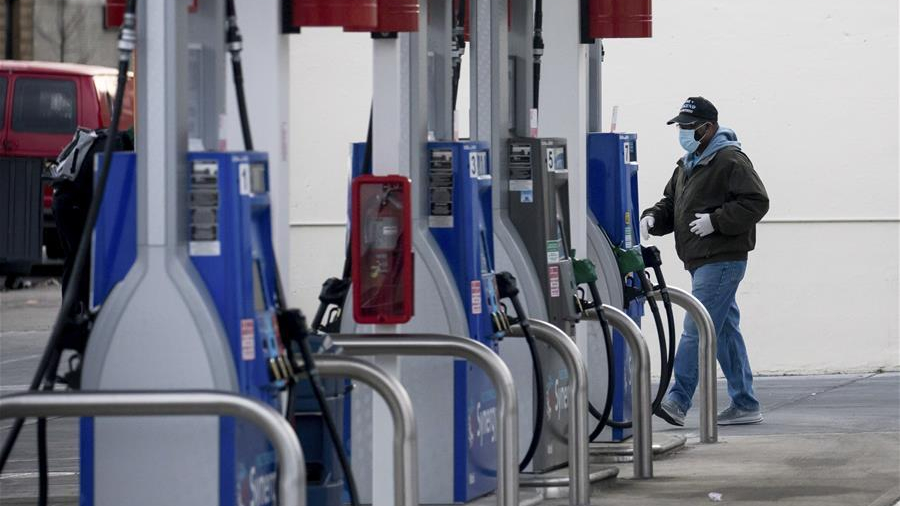
Editor's note: Jeffrey Frankel is professor of Capital Formation and Growth at Harvard University. The article reflects the author's opinions and not necessarily the views of CGTN.
Prices of fossil fuels increased sharply in October. European prices for natural gas hit a record peak. Prices for thermal coal in China have also reached all-time highs. The price of U.S. crude oil is above $80 a barrel, its highest level in seven years, prompting U.S. President Joe Biden's administration in August to call on OPEC and other major oil-exporting countries to increase production.
Although these high prices partly reflect country-specific factors, there must be some more fundamental cause. After all, as with fuel prices, indices of mineral and agricultural commodity prices have also recovered from a six-year slump, re-attaining their 2014 levels. The long-standing correlation of different commodity prices suggests a common macroeconomic explanation. And the obvious reason why energy prices have risen in 2021 is rapid global economic growth.
But what are the environmental implications of elevated fossil-fuel prices, specifically with respect to the fight against climate change? The question is particularly salient as officials from over 200 countries prepare to gather in Glasgow for the UN Climate Change Conference (COP26), where they are expected to declare their intention to achieve net-zero carbon-dioxide emissions by 2050.
On one hand, the effect of high oil, gas, and coal prices on consumers is good for the environment, because they discourage demand for fossil fuels. On the other hand, the effect of high prices on producers is bad for the environment, because they encourage supply.
But today's higher fossil-fuel prices have so far provided a weaker-than-expected stimulus to private investment in the sector. This suggests that firms may have reached a tipping point in how seriously they take the need to combat global warming. They know a green-energy transition is coming.
Now might therefore be the right time for the United States to reconsider a carbon tax or a (largely equivalent) system of tradable emissions permits, also known as "cap and trade." Currently, much of the revenue from higher oil and gas prices goes to Russia, Saudi Arabia, and other foreign producers. Why not keep this revenue at home? The proceeds of the tax or permit auction could be returned as a dividend to citizens by cutting other taxes, thereby maximizing the scheme's political acceptability.

A man wearing a face mask passes by gas pumps at a gas station in the Brooklyn borough of New York, the United States, April 20, 2020. /Xinhua
A man wearing a face mask passes by gas pumps at a gas station in the Brooklyn borough of New York, the United States, April 20, 2020. /Xinhua
The important point is that putting a price on carbon would be by far the most efficient way to achieve the CO2-emissions reductions necessary to limit global warming to 1.5 degrees Celsius, relative to pre-industrial levels.
In the U.S., a cap-and-trade system has been considered politically impossible since the demise in Congress of the McCain-Lieberman Climate Stewardship Act in 2007 and the Waxman-Markey American Clean Energy and Security Act in 2009. But perhaps the failure earlier this month of Biden's attempt to get a clean electricity program through Congress offers an opening for a sensible alternative: a carbon tax.
True, the effective regulation of greenhouse-gas (GHG) emissions – such as through a carbon tax or a cap-and-trade scheme – can generate strong political resistance anywhere. Lawmakers may balk at imposing an extra operating cost on U.S. manufacturers if so-called carbon leakage, or the relocation of carbon-intensive activities to countries with a lower carbon price, put these firms at a competitive disadvantage.
But, logically, the U.S. is perhaps the last country that should worry about others free-riding on its climate efforts. The free-rider problem discouraging most other countries from fully implementing the 2015 Paris climate agreement is above all a fear that the U.S. will not take strong action to cut GHG emissions. If America assumes a climate leadership role, others are likely to follow.
The U.S. has historically been the world's largest CO2 emitter. China now emits far more in total, but U.S. per capita emissions are still more than twice as high as China's.
European countries have perhaps done the most to cut emissions. And ironically, the supposedly more statist Europeans have adopted market mechanisms in pursuit of this goal, while the market-oriented U.S. has considered this approach to be less feasible politically than direct regulation.
Europe has two particularly important market mechanisms: high taxes on gasoline, and the European Union's Emissions Trading System. This scheme's current substantial price of €59 ($69) per ton of emitted CO2 is credibly expected to rise over this decade.
What about countries that don't do their fair share? The EU is now moving forward with a carbon border adjustment mechanism, which imposes a levy on imports of carbon-intensive steel, aluminum, cement, fertilizer, and electricity from countries that are not imposing a carbon price comparable to the EU's.
In general, there is an acute danger that such border adjustment tariffs could be protectionist and violate World Trade Organization rules. But they need not do so if implemented under rules established multilaterally as an adjunct to the Paris accord. An elementary requirement of such a regime is that the country, or group of countries, that imposes a carbon border adjustment tariff (CBAT) must be a participant in good standing under the international agreement.
The U.S. would not currently meet this requirement. It would first need to do its share to fight climate change before it qualified for a U.S. CBAT that could assure domestic industry of continued international competitiveness. The U.S. should thus move swiftly to tax carbon (incidentally reducing the need to import oil).
As the northern winter draws closer, surging fossil-fuel prices have left many consumers worried. But there may be a silver lining in the form of more effective U.S. efforts to tackle climate change – provided the political will for such measures exists.
Copyright: Project Syndicate, 2021.
(If you want to contribute and have specific expertise, please contact us at opinions@cgtn.com.)

